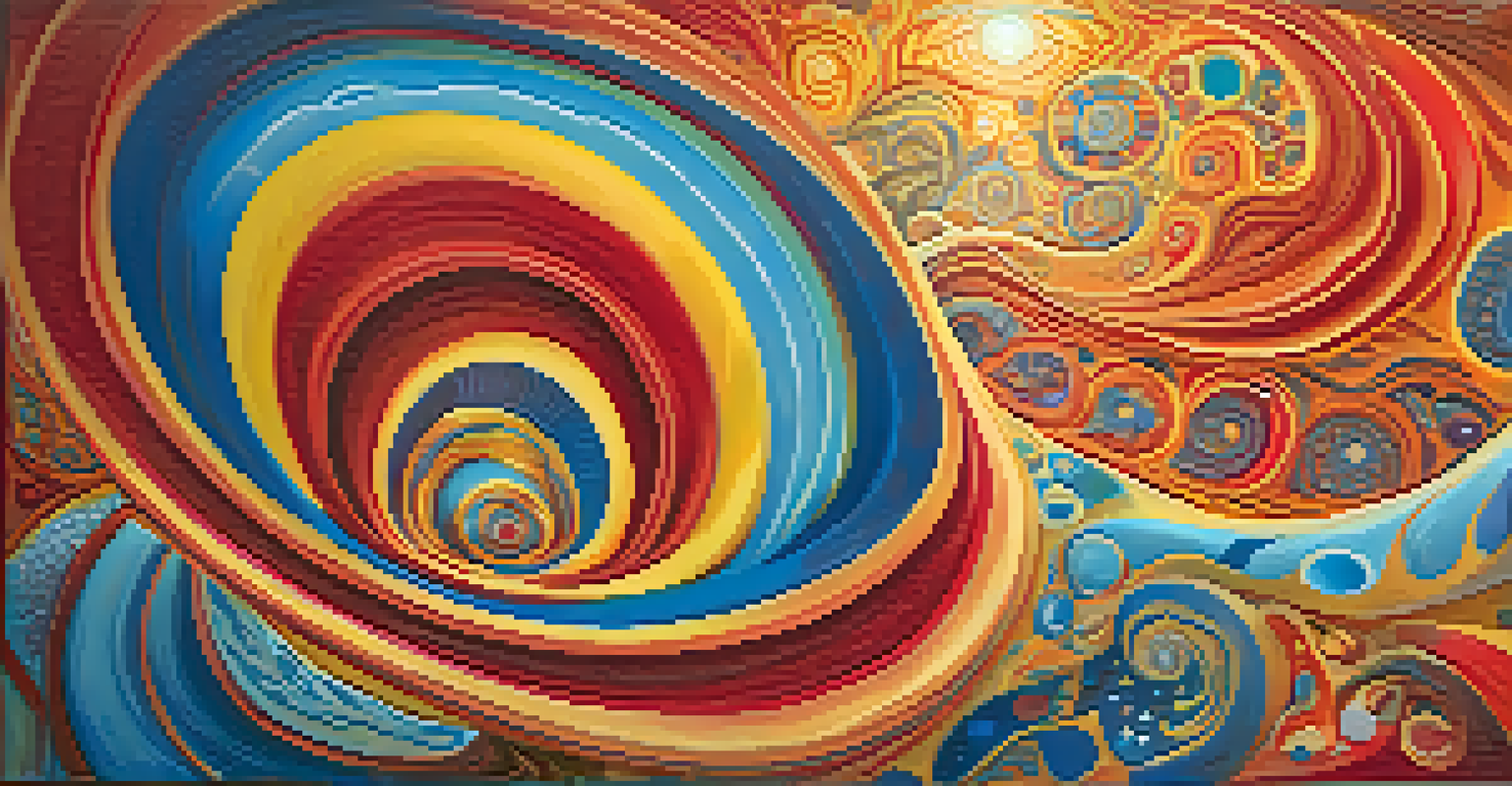Psychedelic Experiences: Dreams vs. Entheogen-Induced States

Understanding Dreams: A Window to the Subconscious
Dreams have fascinated humanity for centuries, often viewed as a bridge to our subconscious. During sleep, our minds weave intricate stories and scenarios that can feel incredibly real, leaving us with lingering emotions upon waking. Unlike waking life, dreams operate on a different logic, where the impossible can seem plausible, allowing for a unique exploration of our thoughts and feelings.
Dreams are the touchstones of our character.
The science behind dreams suggests that they serve various functions, from processing emotions to problem-solving. For example, a person might dream about an unresolved issue at work, providing clarity in a surreal context. This illustrates how dreams can reflect our daily concerns and inner conflicts, acting as a canvas for our subconscious mind's creativity.
Furthermore, dreams often tap into symbolic imagery, making them rich in meaning. While one person might dream of flying as a representation of freedom, another could interpret it as an escape from their responsibilities. This subjective nature of dreams opens up a fascinating dialogue about how our individual experiences shape our dream narratives.
Psychedelics: A Brief Overview of Entheogens
Psychedelics, often referred to as entheogens when used in a spiritual context, are substances that can alter perception, mood, and cognitive processes. Common examples include psilocybin (found in magic mushrooms) and LSD, which have gained popularity for their mind-expanding properties. These substances have been used for centuries by various cultures to facilitate spiritual experiences and connect with the divine.

When someone consumes an entheogen, they often report intense visual and auditory hallucinations, as well as profound insights into their thoughts and emotions. Unlike dreams, which occur during sleep, these experiences unfold in a conscious state, offering users direct engagement with their inner worlds. This conscious exploration can lead to transformative experiences that some describe as life-changing.
Dreams Reflect Our Inner Worlds
Dreams serve as a canvas for our subconscious, processing emotions and reflecting daily concerns.
Moreover, research indicates that psychedelics can promote neuroplasticity, potentially helping individuals confront trauma or anxiety. Imagine peeling back the layers of your mind to address deep-seated issues, much like a gardener tending to a garden. This therapeutic potential is gaining recognition, sparking interest in the integration of psychedelics into mental health treatment.
Comparing Dream States and Psychedelic Experiences
While both dreams and psychedelic experiences can transport individuals to altered states of consciousness, they differ in their accessibility and control. Dreams occur naturally during sleep, with little to no effort required, while psychedelics necessitate intentional consumption. This distinction raises questions about the nature of control and intention in our explorations of consciousness.
Psychedelics are not a panacea; they are tools that can facilitate healing and transformation when used with intention and care.
Additionally, the content of dreams is often a reflection of our daily lives, emotions, and subconscious thoughts, whereas psychedelic experiences can introduce entirely new concepts and perspectives. For instance, someone might dream about a stressful meeting, while a psychedelic experience could prompt a visionary journey into a vibrant, abstract landscape. This contrast highlights how each state offers unique insights.
Moreover, the emotional intensity of psychedelic experiences can sometimes overshadow the subtler revelations found in dreams. While dreams may leave us with lingering feelings, psychedelics can catalyze profound emotional releases or epiphanies, leading to a deeper understanding of ourselves. This variance in intensity adds another layer of complexity to our understanding of these altered states.
The Role of Intent in Psychedelic Journeys
Intent plays a crucial role in shaping the outcomes of psychedelic experiences. Users often enter these journeys with specific goals, whether seeking healing, creativity, or self-discovery. Much like setting intentions before a meditation session, having a clear purpose can guide the experience, allowing for a more meaningful exploration of one’s psyche.
For example, someone aiming to heal from past trauma may find themselves confronted with memories and emotions they need to process. This focused approach can lead to breakthroughs that facilitate healing. In contrast, a more casual approach to psychedelics could yield surprising insights but may lack the depth that intention can provide.
Psychedelics Foster Deep Insights
Psychedelics can lead to profound emotional releases and insights, often facilitating transformative experiences.
Additionally, the setting in which psychedelics are consumed—known as 'set and setting'—also influences the experience. A comfortable and safe environment can enhance positive outcomes, much like the cozy ambiance of a favorite café can transform a simple cup of coffee into a delightful experience. This underscores how intentionality and environment interplay in shaping our consciousness.
Cultural Perspectives: Dreams and Psychedelics
Throughout history, different cultures have revered dreams and psychedelics as gateways to spiritual realms. Indigenous tribes often incorporate entheogens into their rituals, believing they facilitate communication with ancestors or deities. Similarly, dreams have been interpreted as messages from the divine, guiding individuals in their waking lives.
For example, the use of ayahuasca in South American shamanic practices highlights the cultural significance of entheogens in spiritual cleansing and healing. Participants often report profound insights and visions that shape their understanding of life and existence. This cultural context enriches the experiences, making them not just personal journeys but collective rituals.
Conversely, dreams have also been utilized in cultural practices, such as in dream interpretation or as sources of prophecy. Many cultures view dreams as significant, often seeking guidance from elders or shamans to decipher their meanings. This interplay between the two realms illustrates the universal quest for understanding and connection to something greater than ourselves.
Therapeutic Applications: Healing Through Dreams and Psychedelics
The therapeutic potential of both dreams and psychedelics has garnered increasing interest in mental health fields. Psychologists often explore dreams as a means to understand patients' subconscious issues, utilizing techniques like dream analysis to uncover hidden emotions. This method can provide valuable insights into personal struggles, helping individuals navigate their challenges.
Similarly, research on psychedelics is revealing their efficacy in treating conditions such as PTSD, depression, and anxiety. Studies indicate that these substances can facilitate emotional breakthroughs and foster a sense of connectedness, often leading to lasting positive changes. This convergence of therapy and psychedelics represents a promising frontier in mental health treatment.
Cultural Significance of Both States
Various cultures view dreams and psychedelics as gateways to spiritual realms, enriching personal and collective understanding.
Furthermore, the integration of dream work and psychedelic therapy could offer a holistic approach to healing. Imagine combining dream exploration with guided psychedelic sessions, allowing individuals to process their experiences in both realms. This synergy could provide a comprehensive framework for understanding and addressing mental health challenges, paving the way for innovative therapeutic practices.
Navigating the Future: Dreams, Psychedelics, and Society
As society becomes more open to exploring altered states of consciousness, the conversation surrounding dreams and psychedelics is evolving. With increasing research backing their therapeutic potential, psychedelics are slowly shedding their stigma and gaining acceptance in mainstream culture. This shift invites a broader dialogue about mental health and personal growth.
Moreover, the intersection of technology and psychedelics offers exciting possibilities for the future. Virtual reality experiences, for example, could simulate psychedelic-like journeys, providing accessible avenues for exploration without the risks associated with substance use. This innovation could democratize access to transformative experiences, making them available to a wider audience.

Ultimately, the journey of understanding dreams and psychedelics continues to unfold. As we delve deeper into the realms of consciousness, we may uncover profound truths about ourselves and our place in the universe. This exploration not only enriches our individual lives but also fosters a collective understanding of human experience, bridging the gap between the ordinary and the extraordinary.